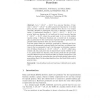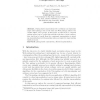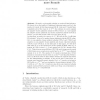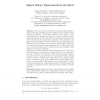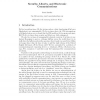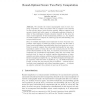CRYPTO
2004
Springer
15 years 4 months ago
2004
Springer
Let f : {0, 1}n {0, 1}l be a one-way function. A function h : {0, 1}n {0, 1}m is called a hard-core function for f if, when given f(x) for a (secret) x drawn uniformly from {0, 1}n...
90
Voted
CRYPTO
2004
Springer
15 years 4 months ago
2004
Springer
Abstract. We study the problem of broadcasting confidential information to a collection of n devices while providing the ability to revoke an arbitrary subset of those devices (and...
CRYPTO
2004
Springer
15 years 6 months ago
2004
Springer
Pairing-based cryptosystems rely on bilinear non-degenerate maps called pairings, such as the Tate and Weil pairings defined over certain elliptic curve groups. In this paper we s...
98
Voted
CRYPTO
2004
Springer
15 years 6 months ago
2004
Springer
We study cryptographic attacks on random Feistel schemes. We denote by m the number of plaintext/ciphertext pairs, and by k the number of rounds. In their famous paper [3], M. Luby...
CRYPTO
2004
Springer
15 years 6 months ago
2004
Springer
The most common method for computing exponentiation of random elements in Abelian groups are sliding window schemes, which enhance the efficiency of the binary method at the expens...
CRYPTO
2004
Springer
15 years 6 months ago
2004
Springer
A timestamping scheme is non-interactive if a stamper can stamp a document without communicating with any other player. The only communication done is at validation time. Non-Inte...
110
click to vote
CRYPTO
2004
Springer
15 years 6 months ago
2004
Springer
Abstract. In this paper we propose a new key recovery attack on irregular clocked keystream generators where the stream is filtered by a nonlinear Boolean function. We show that t...
80
Voted
CRYPTO
2004
Springer
15 years 6 months ago
2004
Springer
93
Voted
CRYPTO
2004
Springer
15 years 6 months ago
2004
Springer
In this paper, we show that a key encapsulation mechanism (KEM) does not have to be IND-CCA secure in the construction of hybrid encryption schemes, as was previously believed. Tha...
94
Voted
CRYPTO
2004
Springer
15 years 6 months ago
2004
Springer
Abstract. We consider the central cryptographic task of secure twoparty computation, where two parties wish to compute some function of their private inputs (each receiving possibl...
